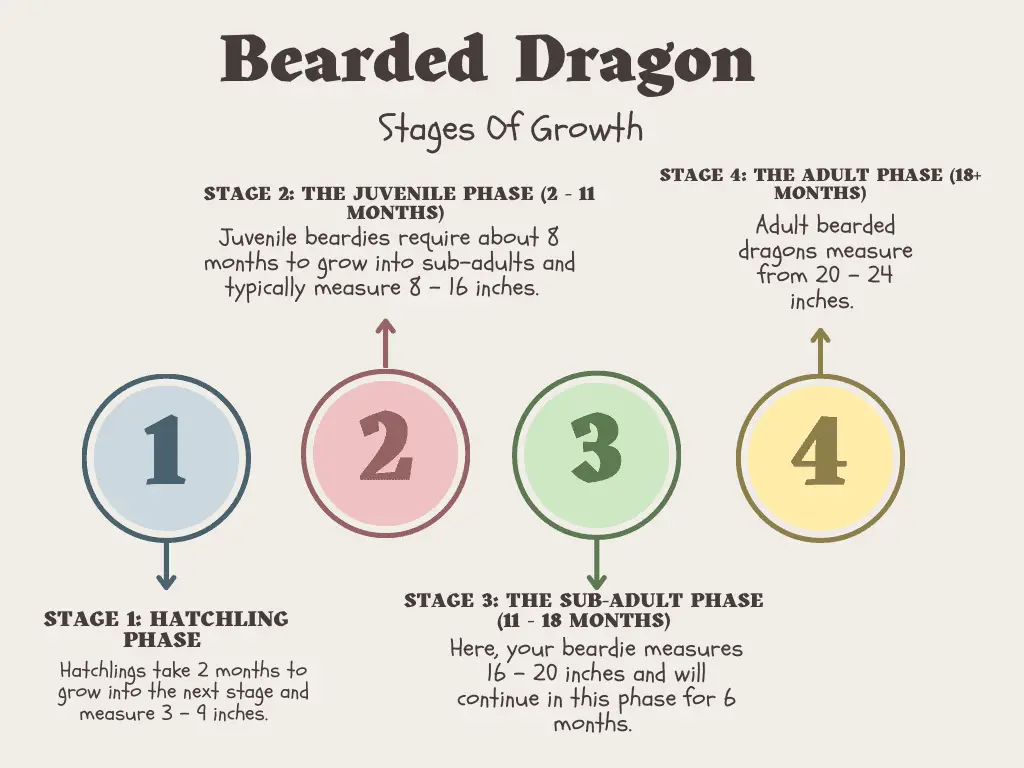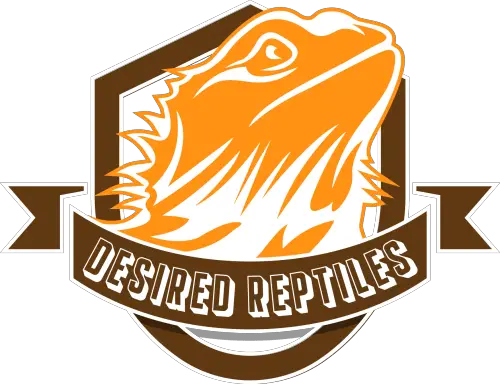Shedding is a necessary part of your bearded dragon’s growth, and one thing we can agree on – both beardies and their owners – is that it is an uncomfortable process. If you’re a newbie, I understand how this ordeal can be concerning for you. How do you know if everything is going as expected? Is there something wrong with your beardie that you’re missing?
Bearded dragons shed depending on their growth rate. During the first year, they shed once every other month. The frequency declines to once or twice a year when they’re over a year old. Therefore, you can expect and experience slightly different patterns at every stage of your beardie’s growth.
Why Do Bearded Dragons Shed?
As beardies mature, they outgrow their skin. This is because their skins are not stretchy or flexible, nor can they replace their dead cells as we do. If a bearded dragon is unable to shed its skin, it can obstruct blood circulation and movement in some parts of the body. Experts at VCA Animal Hospital have confirmed that overlapping skin in certain areas leads to avascular necrosis. Further studies prove prolonged gangrene from necrosis can lead to death. In essence, your bearded dragon needs to shed its skin to stay alive.
Main reasons why bearded dragons shed their skin:
- To keep up with their growing bodies
- To heal injuries and rid parasites
- To improve blood circulation
- To absorb UVB rays better
- For better camouflage
To fully understand your pet’s shedding process, you need to learn the stages of its growth. This will help you monitor each shedding session and prepare in advance. Here’s a fun diagram of the stages.

How Much Shedding Does A Bearded Dragon Need?
Beardies need as much shedding as their growth rate requires. They increase in mass and size as they progress through each stage, which requires them to shed.
Baby beardies grow quickly into juveniles and then adults, so they may shed twice a month. Usually, it takes them about 5 to 7 days for a complete body shed, typically peeling off the entire skin at once.
Once they reach maturity at 12 months old, they shed less frequently and over longer periods, since they’ve attained their optimal size. As adults, beardies shed their old skin in sections. So, your adult dragon may start shedding its tail, head, limbs, or torso with the process lasting about 2 weeks to a month.
| Stage/Age | Shedding Frequency | Duration |
|---|---|---|
| Hatchling beardies (0 – 2 months) | Every other week (the first shed starts around week 4) | 5 to 7 days |
| Juvenile beardies (3 – 6 months) | Once a month | 5 to 7 days |
| Subadult beardies (6 – 12 months) | Every other month | 3 – 4 weeks |
| Adult beardies (12 – 18 months) | 1 to 2 times a year | 3 – 4 weeks |
5 Major Bearded Dragon Pre-Shedding Behaviors to Look Out For
When your beardie is about to shed, you’ll notice some specific behaviors. Fortunately, it’s easy to detect when your dragon has started its shedding process. Below are all the signs you can easily identify:
1. Lethargy
Lethargy is the lack of vigor or activity in bearded dragons and can be associated with changes that occur in various stages of a dragon’s life. Since shedding is an uncomfortable process for your bearded dragon, it may cause it to look tired before and during the shedding. You’ll find your pet lounging more often, sleeping more than usual, and taking more time to move around instead of swiveling through the tank as quickly as it usually does.
2. Unstable Appetite
If you notice a sudden change in appetite such as an increase or decrease, your bearded dragon may be about to shed. Beardies might eat less if they feel too uncomfortable, or eat more in response to the tension they feel. Yes, bearded dragons can stress-eat too! Although this symptom can be attributed to many other problems, in this case, it can be a clear sign that your beardie is about to shed.
3. Weird Behavioral Changes
If your entire skin were highly sensitive, bulky, itchy, and somewhat painful, you’d probably be unable to interact with your surroundings as usual. The same applies to your pet. During the shedding period, bearded dragons will puff out their beards, hide away more frequently, and be more reluctant to be picked up or touched.
4. More Frequent Basking
When your dragon is going through the struggles of shedding, you’ll find them basking more than usual. It needs the extra energy and heat to carry out the process and to help properly separate the old skin from the new one.
5. Less Vibrant Skin
Bearded dragons turn gray or dull when they’re about to shed because the skin is lifeless and drying off. It appears like a film covering the actual skin making it look dull. Sometimes, you’ll notice the dullness in sections such as the legs or tail instead of the whole body.
Effective Ways to Help Your Beardie Shed Safely
At this point, bearded dragon “experts” are waving their fists in the air, gathering enough intensity to yell reasons why you shouldn’t help your pet shed. While they may be right about that, there are certainly helpful things you can do to relieve your bearded dragon from the discomfort of shedding its skin.
Warm Water Baths
Soaking your bearded dragon in warm water for 15 to 20 minutes at a time will help loosen the crusty skin and speed up the process. Put your beardie in shallow water with a rock to brush against and relieve the itchiness. Your little dragon may swim around to enjoy the slight pressure of the water against its skin.
Provide Rough Surfaces For Your Beardie
If your beardie’s tank is decorated with only smooth items, shedding will be pretty stressful for it and take much longer than needed. Bearded dragons need rough surfaces to rub against to peel off their skin, so, ensure there is a rough rock or a hard-bark log of wood to offer assistance.
Daily Mists
Twice daily, apply a few spritzes to the affected areas to help loosen the dead skin and provide your beardie with temporary relief from itchiness and soreness. Your pet will likely rub its body on any hard surface it finds which can cause tension and soreness in the affected areas.
Cocoa Butter Rubs
If you have pure natural cocoa butter, help your shedding beardie by gently rubbing the open areas of the shedding skin only. Be super careful not to use too much butter or injure your dragon with friction. When applying, do not rub against the opening in an attempt to peel it off. Instead, massage the butter into the skin with gentle taps. Cocoa butter relieves itchiness and injuries, which protects your dragon from cuts and tears, especially around stubborn patches of skin that are difficult to shed, like those on the limbs and tail.
Give Your Beardie Space
When your bearded dragon is shedding, the last thing you should do is hold it too frequently. I would certainly appreciate the solitude during this ordeal. Touching, holding, and handling it can cause you to affect the sore areas, or mistakenly peel off the crust. This could lead to injuries or an infection.
Do Not Peel the Shedding Bits
Picking at the shedding skin is dangerous for your bearded dragon. I know that it’s tempting to help when you see your dragon struggling to peel it off, but please, do not intervene. If the skin has not fallen off, it simply isn’t ready. Pulling it off will only cause injuries and bacterial infections. If you think your pet needs assistance, the best thing to do is take it to the vet for professional help.
Is It Okay For My Beardie to Eat Its Old Skin?
It’s completely normal for bearded dragons to eat their shed skin. They do this instinctively in the wild to prevent predators from tracking them.
Additionally, they eat their skin because it’s nutritious and delicious! It contains calcium that is better recycled than wasted. Though it’s a quirky nutritious act without detrimental effects, you shouldn’t force it to eat the skin if it doesn’t want to, as this could cause stress and more difficulties for the already troubled pet.
Problems That Can Occur When Bearded Dragons Shed
Although rare, it’s possible for things to go downhill when your beardie is shedding its skin. Here are four things to look out for:
Tearing And Injuries
For the same reasons you are advised not to pick your beardie’s shedding skin, beardies can accidentally injure themselves and get infected during the process. These injuries mostly affect the head area where they’re able to scratch the most, but they can also happen to other parts of the body. If you notice any bleeding or swelling, contact your veterinarian immediately for help.
Tightly Fastened Crust
On some occasions, bearded dragons are unable to remove stubborn crusts from areas on their bodies, causing the dead skin to simply remain there. If this happens on the extremities like the limbs and tail, it can cut off the blood supply and cause gangrene. If you see this happening, do not peel off the skin. Instead, contact your vet for professional help. They know exactly what to do!
Blocked Nostrils, Ears, or Eyelids
When the shedding process is almost complete, you may notice a whitish scaly plug sticking out of or around the ears, nostrils, or eyes of your beardie. Usually, the skin on the head falls and pulls these plugs out with it, but on some occasions, the plugs are left behind obstructing your beardie from breathing or seeing properly.
Don’t watch YouTube videos to try and handle it yourself. Please, take your pet to a veterinarian to reduce the possibility of injuries or blindness. These areas are very sensitive and require delicate, professional care.
Not Shedding At All
There is something terribly wrong if your bearded dragon is not shedding its skin, especially if it’s still young. As hatchlings and juveniles, bearded dragons shed frequently to accommodate growth, which usually slows down after a year due to their declining growth rate.
Lack of shedding could be a result of a poor terrarium setup such as incorrect lighting or inadequate UVB rays, as well as the diet your pet is on. It’s highly crucial to get the terrarium setup correctly as it directly affects the development and health of your pet. To ensure your enclosure setup is safe and suitable, I’ve written an article that extensively discusses what your pet needs for a functional terrarium.
If you notice a relent in shedding in your young beardie, accompanied by slow growth or signs of brumation, rush to the vet immediately for a proper diagnosis before the situation worsens.
Wrapping it up
Bearded dragons need to shed to grow. It can be bothersome to see your dragon go through this, but with what we have discussed, you’ll be able to provide all the care it needs. Make sure to visit the vet for better insight if you notice any of the difficulties listed above. Good luck!
